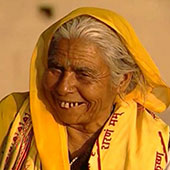.
Jagdish is a cremator at Rasoolabad Ghaat. The Youngest Son of Maharajin Bua has given several interviews about Maharajin Bua.
Interview highlights
• I am the youngest son of Gulaab Maharajin Bua Ji and my name is Jagdish Kumar Tripathi.
• I am working with her since when I was born.
• we won’t talk about my brother because he wasn’t involved in this. He was living separately.
• we were three brothers and two sisters.
• She used to work at Daraganj Ghaat. But it was tough working there. It was a corrupt Ghaat and she never liked it.
• This is a very historic Ghaat. RK Nehru, Mahadevi Verma, Dr Ramkumar Verma, Indira Gandhi and Rajiv Gandhi came. We did everything. I was 30 at that time.
• There was a peepal tree at the backside of Chandrashekhar Azad's tomb. Around 200 eagles used to sit on that tree and it looked like a Shamshaan Ghaat.
• This Ghaat changed a lot. Nobody used to come here. Dead animals used to come here.
• This was famous for corrupt shops, it was like a forest. Nobody used to come here after 5pm.
• People couldn’t understand at first. She faced a lot of problems.
• Her name was Gulaab Maharajin.
• This was due to grandfather. He was a tough man and was dependent on servants.
• She got married at 9.
• She didn’t get this work from her forefathers. She started this work at 10.
• I was born from an operation. I was 8 days old and she took me to Daraganj Ghaat and put me on the Masaan and said that he is my Masaan’s son.
• She was very soft and very tough. Extremely kind and extremely angry.
• She used to say that death is a friend. We have to go with death. Nobody can deny it, we should be friends with death. She used to love people. People used to come to Ghaat to do suicide but she used to stop them.
• She used to work all day but she was always happy. She was very healthy and used to fight with 10 people. She cremated 13 lakhs something and 2 lakhs she cremated herself.
• It was very tough. Religion says, a woman can’t do it and she proved it wrong. Women now come to the Ghaat because of her. When women are together in sadness and happiness then why should get separated in death.
• Women are not scared of anything. Many men are scared of coming here.
• There were times with lots of dead bodies and she used to manage alone.
• She wasn’t allowed in the starting but due to her strong character, she continued it and then she was also allowed by the pandits.
• She was never after money, she just wanted to work perfectly, and never demanded the money.
• She was really different. I used to call her Jagdamba or Malkin. She used to care for everybody. Used to offer money for the cremation.
• She did everything for us. She never liked corrupt people. Students used to come on Ghaat. Used to give resources to them.
• She used to know all the mantras and all languages Punjabi, Bengali and all. This was god gifted.
• Nobody can say that she did something wrong.
• Nobody knew about Chandra Shekhar Azad's tomb.
• She also used to sometimes give shoulders to the body bearers.
• She used to love us a lot. But if we did something wrong, then she used to punish us too.
• I went to Bombay and people talked with me. I didn’t even know about it.
• About Amita Gopesh.
• Now women come here a lot.
• These myths should be ended. Why women are behind. Tell me the reason. Tell me the reason and I am ready.
• She used to wake up and then used to work out, half an hour for rock picking, half an hour for pistol practice, half an hour for knife practise, and she used to carry a pistol.
• She used to have fun with her friends. They were of Maalin cast but they were good.
• She used to sit alone at night near Ghaat. Nobody knew to whom she used to talk with.
• One day a guy came who came here to eat dead bodies. He said I will eat my food. Mom was seating in the Pooja. And he started eating the body. I went to tell mom but she was in Pooja. I told him whatever you are please don’t do this but he didn’t listen then he went.
• She used to sing in marriages and all (ladies sangeet).
• She had seen poverty too. we even sold all the utensils too. we have seen the worst conditions too.
• She was happy with God and the kids. She was very religious. My dad died in 98 and in 2002 my mom.
• I cremated both of them.
• My dad used to respect her too. He used to call her Lakshmi. He was also scared of her.


